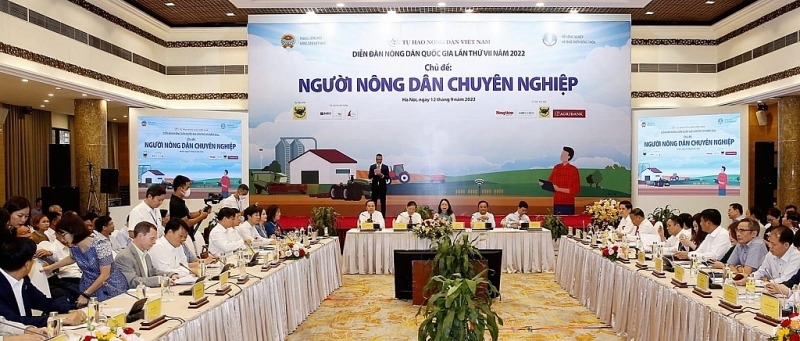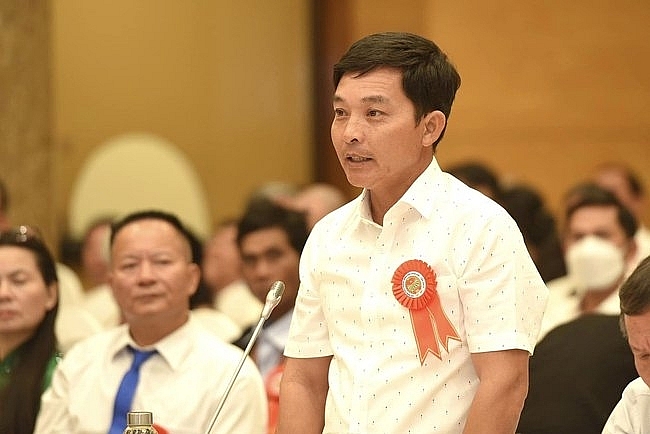 |
| Forum overview |
According to the Ministry of Agriculture and Rural Development, in the past eight months, export turnover of agricultural, forestry and fishery products was estimated at nearly US$36.3 billion, up 13.1% over the same period last year. Specifically, the export of primary agricultural products is nearly $15 billion, up 7.4%; main forest products over $11.8 billion, up 6.2%; seafood over $7.5 billion, up 35.3%; animal husbandry $258.6 million, down 12.2%; and production input was nearly $1.7 billion, up 48.2%.
The agricultural sector recorded seven product groups with an export value of over $2 billion, including coffee, rubber, rice, vegetables, cashews, shrimp, and wood products.
Deputy Minister of Agriculture and Rural Development Phung Duc Tien emphasized that although in the last months of the year, agricultural, forestry and fishery production and export still face many difficulties, the whole industry still pursues to “finish the finish line” and achieve the export target of about $50 billion.
To promote more and more sustainable agricultural, forestry and fishery production and export, ensuring close linkages between farmers and businesses is considered an essential factor.
Sharing at the 7th National Farmers’ Forum on the topic: “Professional farmer” taking place on September 12, farmer Nguyen Van Linh, in My Loc village, Cao Duc commune, Gia Binh district, North province Ninh said: “Currently, Mr Linh’s family and many other farmers are participating in the linkage model of growing carrots for export to Japan and Korea. In fact, since switching to linked business, farmers have become much more professional.”
Linh asked: “What policies will the State have to promote the association between farmers and between farmers and businesses in the coming time, creating more substantive models?”
Similarly, farmer Hoang Thi Chap, Luong Do village, Coc San commune, Lao Cai city, Lao Cai province (a farmer producing fingerlings, successfully crossed Chinese carp with Red river carp, earning an income. of 1.2 – 1.8 billion VND/year) raised the problem, in the recent animal feed price storm, many livestock households suffered heavy losses. However, for large-scale livestock farmers, if there are contracts and long-term business relationships with businesses, the costs are reduced quite a lot.
“I would like to ask, what forms of enterprises producing animal feed and agricultural inputs to shake hands with farmers, towards mutual benefits, and reduce input costs?” Chap said.
After clarifying many farmers’ questions, Johan Van Den Ban, General Director of De Heus Vietnam, said that up to now, De Heus has been present in Vietnam for 12 years with 22 feed mills. In addition, farming is distributed in large livestock areas across the country.
Vietnam has many opportunities to export high-quality livestock products. However, if farmers do not gather and do not link production in chains, producing synchronous, high-quality products that meet export standards will not be easy.
De Heus’s experience in Europe and the world always supports knowledge and techniques to help independent farmers develop better and more efficient production.
In order to promote the linkage chain with Vietnamese farmers and provide animal feed products, De Heus also has important solutions such as breeding chickens and piglets for farmers. Furthermore, in 2023, De Heus will provide solutions to develop pangasius – an important commodity for the Western region.
 |
| Farmer Nguyen Van Linh, from My Loc village, Cao Duc commune, Gia Binh district, Bac Ninh province, speaks at the forum |
According to Ngo Tien Dung, Deputy Director of TH Group Food Chain Joint Stock Company, TH Group has built two sustainable links with farmers. First, enterprises cannot connect with individual farmers but connect with farmers through cooperatives (cooperatives).
However, many farmers are still afraid and lack confidence when joining cooperatives. Therefore, the core problem is how to build a new type of cooperative and clarify what farmers get when participating in cooperatives.
“When joining the linkage chain, the cooperative operates like a business. TH Group is successfully implementing this association model in Lam Dong. Moreover, TH Group builds model farmers, or in other words, demonstration farmers to replicate and attract other farmers to participate,” said Ngo Tien Dung.
According to Le Van Nghi, Vice Chairman of the Vietnam Cooperative Alliance: In agricultural production, there have been many references to the linkages of “3 houses”, “4 houses”, and “6 houses”, but they did not answer the question of why the link of the house is not successful?
The key to this problem lies in the two “houses” of farmers and businesses. Given that a part of both subjects is unprofessional and does not respect the contract, Mr Nghi analyzed: when the crop is lost, farmers “break the contract”; when the price drops, businesses “break the deal”. Therefore, these two “houses” need to be more professional, know how to respect the contract, and be responsible for their commitments.
“In order to limit the situation of “breaking the deal”, the local government must step in and act as an arbitrator to manage this connection so that it is more serious, substantive and professional”, said Vice Chairman of the Vietnam Cooperatives Union.
